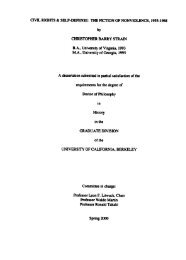Negro Digest - Freedom Archives
Negro Digest - Freedom Archives
Negro Digest - Freedom Archives
Create successful ePaper yourself
Turn your PDF publications into a flip-book with our unique Google optimized e-Paper software.
ployment rate for black youth between<br />
16 and 19 was 26 percent,<br />
more than twice the rate for white<br />
youth .<br />
Between 1960 and 1966, there<br />
were substantial increases in the<br />
number of black people holding<br />
white collar positions, and less dramatic<br />
but still increases for blacks<br />
holding blue collar positions . The<br />
increase in white collar employment<br />
shows the largest gain in clerical<br />
and sales positions . Blacks are<br />
still under-represented in the skilled<br />
white collar positions, as of 1966,<br />
with the situation for black males<br />
and black females showing some<br />
significant differences . In professional<br />
and technical positions black<br />
males represent 42 percent as<br />
many as there would be if there<br />
were full occupational equality,<br />
while females in the same category<br />
represent 58 percent as many as<br />
would be found in a situation of full<br />
equality. On the other hand, in the<br />
clerical positions black males represent<br />
89 percent as many as<br />
would be found in a situation of<br />
full equality while black females<br />
comprise only 39 percent. These<br />
and other data which we have analyzed<br />
indicate that the black female<br />
has a better chance of obtaining a<br />
job consistent with her education<br />
and training than the black male in<br />
the professional, technical and<br />
managerial categories, while black<br />
males are more likely than females<br />
to be adequately represented in<br />
clerical positions .<br />
NEGRO DIGEST March 1968<br />
(Continued on page 84)<br />
The chronic problems black people<br />
face with education, employment,<br />
and occupational levels are<br />
reflected in the income levels of the<br />
population, although the Sixties<br />
have seen changes in income for<br />
blacks . There are varying interpretations<br />
of income changes in the<br />
black community and they produce<br />
different conclusions . Some analysts<br />
talk about the income of families,<br />
while others talk about the<br />
income of persons, and then differentiate<br />
between males and females .<br />
Furthermore, income changes can<br />
be analyzed in terms of the percentage<br />
change in median income, the<br />
ratio of black to white median income,<br />
or the absolute black-white<br />
differences in income. Let us see<br />
how the black situation in the Sixties<br />
stands up in terms of all these<br />
measurements .<br />
In 1960, 68 percent of all black<br />
families had incomes under $5,000<br />
per year (36 percent of all white<br />
families were at this level), but by<br />
1966 this had declined to 56 percent<br />
of all families ( 27 percent<br />
for whites) . The proportion of<br />
black families with incomes between<br />
$5,004 and $10,000 went up<br />
from 27 to 33 percent (white families<br />
declined from 46 to 44 percent),<br />
between 1960 and 1966 .<br />
Black families with incomes over<br />
$10,000 went up from 6 to 12 percent<br />
in the same period of time<br />
(with a corresponding increase<br />
from 18 to 30 percent for white<br />
families) . These figures are ad-<br />
3 1
















